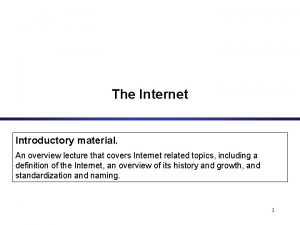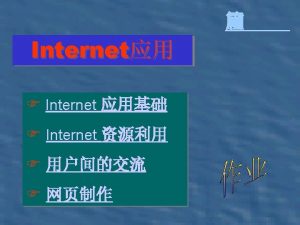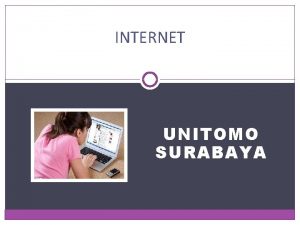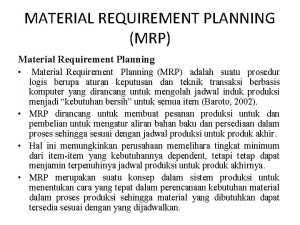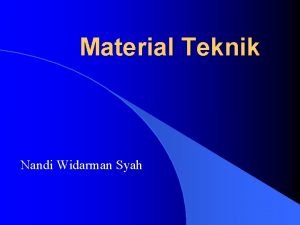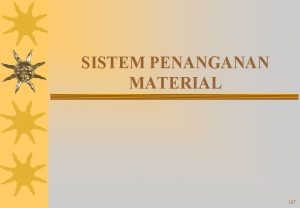The Internet Introductory material An overview lecture that


















- Slides: 18

The Internet Introductory material. An overview lecture that covers Internet related topics, including a definition of the Internet, an overview of its history and growth, and standardization and naming. 1

A Definition • On October 24, 1995, the FNC unanimously passed a resolution defining the term Internet. • RESOLUTION: The Federal Networking Council (FNC) agrees that the following language reflects our definition of the term "Internet" refers to the global information system that - • (i) is logically linked together by a globally unique address space based on the Internet Protocol (IP) or its subsequent extensions/follow-ons; • (ii) is able to support communications using the Transmission Control Protocol/Internet Protocol (TCP/IP) suite or its subsequent extensions/follow-ons, and/or other IP-compatible protocols; and • (iii) provides, uses or makes accessible, either publicly or privately, high level services layered on the communications and related infrastructure described herein. 2

History of the Internet Mid 1960: Papers on “Packet Switching” emerge. End 1969 s: ARPA sponsors the development of a packet-switching network, called the ARPANET. First four nodes are UCLA, SRI, U. Utah, UCSB. 1974: The TCP/IP protocols and model are being proposed by Cerf/Kahn. 1980: IPv 4 is introduced 1983: ARPANET adopts TCP/IP. At this time, the ARPANET has 200 routers. 1984: NSF funds a TCP/IP based backbone network. This backbone grows into the NSFNET, which becomes the successor of the ARPANET. 1995: NSF stops funding of NSFNET. The Internet is completely commercial. 3

Applications of the Internet • Traditional core applications: Email News Remote Login File Transfer • The killer application: World-Wide Web (WWW) • New applications: Videoconferencing Telephony P 2 P applications Internet Broadcast 4

Time Line of the Internet • Source: Internet Society 5

Growth of the Internet Source: Internet Software Consortium 6

Internet Infrastructure 7

Internet Infrastructure • The infrastructure of the Internet consists of a federation of connected networks that are each independently managed (“autonomous system”) – Note: Each “autonomous system may consist of multiple IP networks – Autonomous systems have a number (AS number) • Hierarchy of network service providers (NSPs) – Tier-1: nation or worldwide network (US: less than 20) – Tier-2: regional networks (in US: less than 100) – Tier-3: local Internet service provider (in US: several thousand) 8

Internet Infrastructure • Location where a network (ISP, corporate network, or regional network) gets access to the Internet is called a Point-of. Presence (POP). • Locations (Tier-1 or Tier-2) networks are connected for the purpose of exchanging traffic are called peering points. – Public peering: Traffic is swapped in a specific location, called Internet exchange points (IXPs) – Private peering: Two networks establish a direct link to each other. 9

Topology of a Tier-1 NSP 10

Organization of a single node in a Tier-1 network 11

Who is Who on the Internet ? • • • Internet Society (ISOC): Founded in 1992, an international nonprofit professional organization that provides administrative support for the Internet. Founded in 1992, ISOC is the organizational home for the standardization bodies of the Internet Engineering Task Force (IETF): Forum that coordinates the development of new protocols and standards. Organized into working groups that are each devoted to a specific topic or protocol. Working groups document their work in reports, called Request For Comments (RFCs). IRTF (Internet Research Task Force): The Internet Research Task Force is a composed of a number of focused, long-term and small Research Groups. Internet Architecture Board (IAB): a technical advisory group of the Internet Society, provides oversight of the architecture for the protocols and the standardization process The Internet Engineering Steering Group (IESG): The IESG is responsible for technical management of IETF activities and the Internet standards process. Standards. Composed of the Area Directors of the IETF working groups. 12

Internet Standardization Process • Working groups present their work i of the Internet are published as RFC (Request for Comments). RFCs are the basis for Internet standards. • Not all RFCs become Internet Standards ! (There are >3000 RFCs and less than 70 Internet standards) • A typical (but not only) way of standardization is: – Internet Drafts – RFC – Proposed Standard – Draft Standard (requires 2 working implementation) – Internet Standard (declared by IAB) 13

Assigning Identifiers for the Internet • Who gives the university the domain name “virginia. edu” • Who assigns it the network prefix “ 128. 143. 0. 0/16”? • Who assigns port 80 as the default port for web servers? • The functions associated with the assignment of numbers is referred to as Internet Assigned Number Authority (IANA). • IANA used to be managed by Jon Postel at ISI • Since the 1990 s, IP addresses and domain name allocation are delegated to independent organizations. Different organizations are responsible for allocating domain names and IP addresses 14

The IANA Function • The functions associated with the assignment of numbers in the Internet is referred to as Internet Assigned Number Authority (IANA). • IANA serves as a registry that keeps records of assigned numbers: – IP addresses – Protocol numbers – Domain names (until 1992) • There is no charge for allocation. 15

Regional Internet Registries (RIRs) • Registration and management of IP address is done by Regional Internet Registries (RIRs) • Where do RIRs get their addresses from: IANA maintains a high-level registry that distributes large blocks to RIRs • RIR are administer allocation of: – IPv 4 address blocks – IPv 6 address blocks – Autonomous system (AS) numbers • There are currently 4 RIRs worldwide: – APNIC (Asia/Pacific Region), – ARIN (North America and Sub-Sahara Africa), – LACNIC (Latin America and some Caribbean Islands) – RIPE NCC (Europe, the Middle East, Central Asia, and African countries located north of the equator). • A fifth regional registry (Afri. NIC) is in formation for Africa. 16

Transitioning of Domain Name Registration • Until 1992: Domain name registration done as part of IANA • 1992: Inter. NIC was created in a partnership between US government and companies to organize and maintain the growing DNS registry and services. The company Network Solutions ran the administration of Inter. NIC. Until 1998, Network Solutions had a monopoly for domain names. • 1995: Inter. NIC started harging for domain names ($100 for 2 years) • 1997: President Clinton directs the Secretary of Commerce to privatize the management of the domain name system (DNS) in a manner that increases competition and facilitates international participation in its management. • 1998: ICANN was created in response to a policy statement issued by the US Department of Commerce that called for the formation of a private sector not-for-profit Internet stakeholder to administer policy for the Internet name and address system. ICANN operates under a renewable 3 year contract with the US Department of the Commerce. – ICANN accredits domain-name registrar for. com, . org. , . net (and other domain) 17

ICANN • The Internet Corporation for Assigned Names and Numbers (ICANN) is an internationally organized, non-profit corporation that has responsibility for Internet Protocol (IP) address space allocation, protocol identifier assignment, Top-Level Domain name system management, and root server system management functions. – ICANN performs the IANA functions – ICANN accredits domain-name registrar for. com, . org. , . net (and other domain) • Since ICANN performs the IANA functions, it is in charge for allocating all numbers. However, the main concern is the allocation of domain names. • ICANN role is to oversee the domain-name registration system's transition from government hands to private hands and to coordinate its decentralization and the integration into a 18 global community.
 Introductory material
Introductory material Phân độ lown
Phân độ lown Block xoang nhĩ ecg
Block xoang nhĩ ecg Thể thơ truyền thống
Thể thơ truyền thống Thơ thất ngôn tứ tuyệt đường luật
Thơ thất ngôn tứ tuyệt đường luật Walmart thất bại ở nhật
Walmart thất bại ở nhật Tìm vết của mặt phẳng
Tìm vết của mặt phẳng Hãy nói thật ít để làm được nhiều
Hãy nói thật ít để làm được nhiều Tôn thất thuyết là ai
Tôn thất thuyết là ai Gây tê cơ vuông thắt lưng
Gây tê cơ vuông thắt lưng Sau thất bại ở hồ điển triệt
Sau thất bại ở hồ điển triệt 01:640:244 lecture notes - lecture 15: plat, idah, farad
01:640:244 lecture notes - lecture 15: plat, idah, farad Virtual condition in gd&t
Virtual condition in gd&t Standard costing formula
Standard costing formula Cultural relativism definition
Cultural relativism definition Material and non material culture examples
Material and non material culture examples Examples of non material culture
Examples of non material culture Useful materials in home
Useful materials in home What is internet
What is internet
